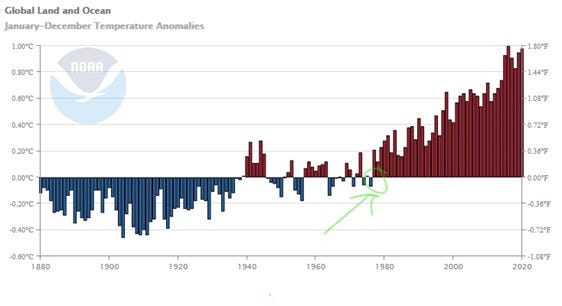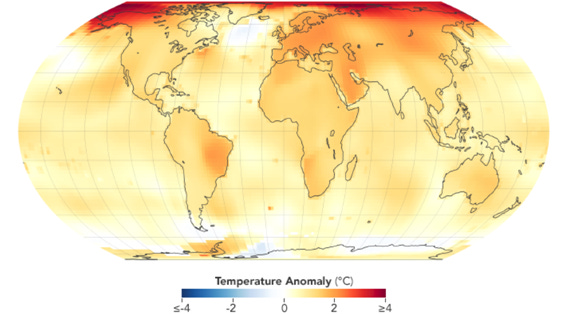The Crisis Report - 05
Global Warming accelerated between 2010 and 2020. It's catastrophically bad news.
Do you know the current “rate of warming” for Global Warming?
You should, that number is the NUMBER that controls what the rest of your life is going to be like.
Here’s a Climate Change trivia question, “What was the last year that global temperatures were lower than the 1951–1980 baseline i.e., what was the last cold year on record?”
This question occurred to me recently and to my surprise I realized I didn’t know. I couldn’t remember a year when the earth cooled down instead of heating up. I had to look the answer up and it both surprised and saddened me.
Because it was 1976.
Since 1976 our planet has continuously warmed year after year as the CO2 level in the atmosphere has climbed, year after year.
Someone born in 1976 has lived their entire life in a rapidly warming world. A world where approximately 4 billion atomic bombs worth of energy has accumulated in the oceans.

They, and everyone else born since 1976, are going to have to live with the consequences of our “carbon bomb”. They are the ones who are going to have to “pick up the tab” for what we did, and that bill is coming due.
Because things are rapidly getting worse.
In 2022, global temperatures were between 1.1 and 1.2 degrees Celsius (2.2 degrees Fahrenheit) above the preindustrial average. This happened despite it being a La Niña year in the Pacific Ocean, a weather pattern which tends to cool the planet.
It underscores the extent to which human greenhouse gas emissions have fundamentally and irrevocably changed the planet. Even the not-quite-so-bad years are dramatically worse than anything that could have been imagined a generation ago.
Natural variation, like the cooling influence of La Niña, can barely put a dent in the man-made warming trend.
It was the eighth year in a row in which global temperatures were more than 1 degree Celsius above the preindustrial average. Short of geoengineering the climate, no one alive today will ever see the world’s temperature drop below that 1-degree benchmark again.
There is no going back.
Let me ask you a question, “how much do you think the planet has warmed up since 1980?”

This is an important question, and it deserves more thought than most people give it. It’s complicated and, depending on how you choose to measure it, you will get a range of answers.
The Climate Action Resistance (CARs) Answer
Climate Action Resisters (CARS) argue that it’s only about 0.6℃.
“Sure, it looks higher” they say, but what you are seeing is “natural variation” piled on top of a moderate amount of human GHG (Green House Gas) warming. “We mustn’t let Alarmists and Doomists panic us into an ill-considered rapid decarbonization of our global economy” goes their argument.
There was a huge El Nino event in 2016 and that’s distorting the global temperature right now. You have to look at warming over the long term to have a real understanding of what’s happening.
If you measure from 1880 the planet has only warmed up about 1.2℃. Sure, 2/3 of that warming has happened since 1980. Which is concerning, and something that we need to start addressing. But it’s hardly a crisis.
The “Official” Answer
Governmental agencies like the GISS are pegging the number at around 0.8℃.
Their argument is similar to that of the CARS. They state that the planet has warmed 1.2℃ since “the late 19th century” and since 1980 that warming has been at a rate of a 0.18℃ per decade.
If you do the math (0.18 x 4) this works out to 0.72℃ of warming. Add a few hundredths of a degree by including warming from the late 70’s and “voilà” you get 0.8℃ of warming since 1980.
Like the CARS, they urge “measured” consideration of the data from 2010 to 2020.
Sure, 2021 was 1.1℃ hotter than the 1950–1980 baseline. But single year measurements are meaningless.
Planetary warming and cooling are slow processes that happens on millennial timescales. Even decadal trends can be deceptive. Natural variation or a volcanic eruption can distort the temperature for a whole decade.
There was a huge El Nino event in 2016 and residual heat from that event is probably adding 0.2 to 0.3 of warming to the years since then. You have to use a longer timeline to realistically assess the impact of human GHG emissions.
Measured from “the late 19th century” there has been about 1.2C of warming, or about 0.08℃ per decade on average. Which is all we can really be certain of.
The Official GISS/NOAA Conclusion:
The science is unequivocal; this warming is caused by human GHG emissions, and the planet will continue to warm if we continue to dump CO2 and other GHGs into the atmosphere. Immediate governmental action on a global scale is required to facilitate the “phasing out” of fossil fuels and accelerate the transition to a “Net Zero” global economy.
However, overstating the problem is “bad science” and counterproductive. With appropriate policy choices the goal of containing global warming to 1.5℃ is still possible.
As an analyst, here’s what I see:

I see an abrupt jump in temperatures starting around 2013 of 0.2℃ to 0.3℃ degrees of warming.
I see no cooling down after the 2016 El Nino. I see temperatures of 1.1℃ in a La Nina “cold” year. I see a lot of heat being suddenly added to the climate system and I really want to know where it came from.
Because with global warming, a “few tenths of a degree that no one cares about” represents a decade of warming. This jump is the equivalent of getting an extra ten years of warming dumped on us in addition to the expected warming from 2010 to 2020.
Because heat doesn’t “just happen”.
This unexpected heat had to come from somewhere. Scarily, all of the “somewhere’s” have serious implications for the next ten years.
This is what I see.
This is my analysis.
This is my “Crisis Report”.
-rc







